Facts About Eurasian bittern
The Eurasian bittern, also known as the great bittern, is a captivating wading bird that belongs to the heron family, Ardeidae. There are two main subspecies: the northern race, which is distributed across Europe, Africa, and Asia, and the southern race, which is restricted to certain regions of southern Africa. These birds are quite elusive, often concealing themselves in reed beds and dense vegetation near water. One of their most distinctive attributes is their booming call during the breeding season.
Regarding their diet, the Eurasian bittern is not particularly selective. It feeds on fish, small mammals, birds, amphibians, crustaceans, and insects. The female shoulders the responsibility of nesting among reeds near water, incubating the eggs, and nurturing the chicks until they are ready to fledge.
Unfortunately, the Eurasian bittern is experiencing a gradual decline in population due to habitat loss and the reduction of wetlands. Although the International Union for Conservation of Nature (IUCN) lists it as "Least Concern" overall, some local populations, especially the southern race, are experiencing significant declines.
The Eurasian bittern was first described by Thomas Browne and Carl Linnaeus. It is closely related to other bittern species. The name "Botaurus" derives from the Middle English word for bittern, while "stellaris" refers to its speckled plumage. Over time, this bird has acquired various folk names that reflect its habitat and distinctive call.
In terms of appearance, Eurasian bitterns are stocky herons with buff-brown feathers marked with dark streaks. They are the largest of the bittern species, with males being larger than females. They prefer habitats such as reed beds, swamps, lakes, and rivers with dense vegetation. When foraging, they move stealthily near water, hunting for a variety of prey.
Their call, known as a "boom" is particularly notable during the breeding season. The bird's secretive nature and unique behaviors, such as "bitterning" (a form of camouflage), and its foraging habits, add to its mystique. Despite being shy, the Eurasian bittern has made appearances in literature, folklore, and mythology.
Conservation efforts are essential to protect the Eurasian bittern, especially in regions where populations are dwindling. Strategies like habitat restoration and wetland conservation are crucial. Increasing awareness and supporting conservation initiatives can help ensure that the Eurasian bittern continues to thrive in its natural environment.

 Austria
Austria